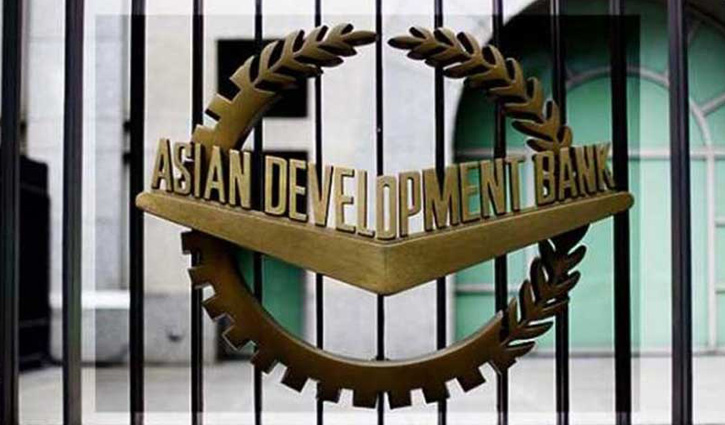Staff Correspondent
Published:2025-04-10 16:37:55 BdST
ADB considerably cuts BD's growth forecast
The Asian Development Bank (ADB) has significantly cut Bangladesh's economic growth forecast, suggesting necessary reforms by this government to achieve higher growth.
It has also drawn a grim picture for Bangladesh as it says the global economic slowdown sparked by the sweeping US tariff may hit GDP (gross domestic product) expansion.
The Manila-based lender cut the GDP projection significantly by 1.20 percentage points to 3.9 percent for fiscal year (FY) 2024-25 from that of its earlier projection last September, according to the ADB's Asian Development Outlook (ADO).
The economic growth outlook was unveiled in Dhaka on Wednesday.
The ADO in September 2024 forecasted that Bangladesh would expand at 5.1 percent rate in the FY2025. Its economic growth projection in April 2024 was much higher at 6.6 percent.
Meanwhile, the ADB has forecast a better economic picture for Bangladesh in FY2026 as it projected 5.1-percent growth.
"Slower growth in services owing to political unrest, financial sector vulnerability and reduced household purchasing power will tamp down GDP growth in FY2025," reads the ADO.
The ADB unveiled the ADO April 2025 across the globe under which Bangladesh resident mission launched the Bangladesh part at its Dhaka office.
About the US tariff impact on Bangladesh, ADB country director in Bangladesh Hoe Yun Jeong said: "Growth could be hit by stubbornly high inflation, prolonged monetary tightening, political uncertainty, adverse weather events and global economic slowdown sparked by the USA's sweeping tariff."
He said Bangladesh would definitely be affected through the fresh US tariff regime, but it is tough to assess possible shocks at this moment.
"In the July 2025 Outlook, we will analyse the US tariff impact elaborately," Mr Jeong told journalists.
"The US is the largest export market for Bangladesh. So, given this, the tariffs are expected to adversely impact export earnings."
Furthermore, if these tariffs unleash an economic downturn not only in the US, but also in other exporting markets, particularly in the EU, the potential decrease in export demand could also negatively impact economy growth of Bangladesh.
"So, the full impact would depend on the trade diversion and also potential economic slowdown in major markets over time. So, it is, quite frankly, too early to tell the exact scale of the impact on the Bangladesh economy," cited Mr Jeong.
"We will continue to conduct analytical work on this impact and details may be projected at the July 2025 ADO update. But on the other hand, we also noted that the RMG exporters such as Cambodia, Vietnam and PRC are also facing higher tariffs than Bangladesh."
Mr Jeong suggested Dhaka engage proactively and negotiate with Washington.
"Of course, engaging and negotiating with the US government is important, but this is a sort of short-term measure. More importantly, export must diversify its products and markets for the medium- to long-term perspective."
"Bangladesh should apply tax liberalisation not only for the USA, but also for other countries. So, these are the broad measures that the government of Bangladesh may need to take into account going forward as potential mitigation measures," added the ADB country director.
About inflation, the latest ADO has projected it to an average 10.2-percent rate in FY2025, which is expected to ease at 8.0 percent in FY2026.
According to the ADB report, the government's revenue collection is anticipated to rise slightly to 8.7 percent of GDP in FY2025.
Revenue collected by the revenue board contracted by 1.0 percent in the first half of FY2025 over the same period in the previous year due to sluggish economic growth, inflationary pressures, lower FDI and decreased imports.
Despite this poor performance, overall revenue collection is expected to improve, as in January 2025, it tripled value-added tax to 15 percent from 5.0 percent and the supplementary duty for many items by more than 50 percent.
Total government expenditure is projected to rise to 12.7 percent of GDP in FY2025, reflecting larger subsidy payments, including those provided to state-owned enterprises in the energy sector to help clear their external arrears.
On balance, the fiscal deficit is expected to remain steady at 4.0 percent of GDP in FY2025. It is likely to remain unchanged in FY2026 due to fiscal consolidation intended to counter inflationary pressures, reads the ADO.
About the downside risk, the ADB report said higher election-related spending and subsidies could raise inflation and the fiscal deficit.
Growth could be hit by persistently high inflation, prolonged monetary tightening or a drop in official remittance inflows due to political uncertainty or inadequate exchange rate adjustment, it added.
Unpredictable weather is a perennial risk. The effect of reciprocal US tariffs on Bangladeshi exports and a possible economic slowdown in major export destinations may affect growth prospects, according to the ADB.
Unauthorized use or reproduction of The Finance Today content for commercial purposes is strictly prohibited.


